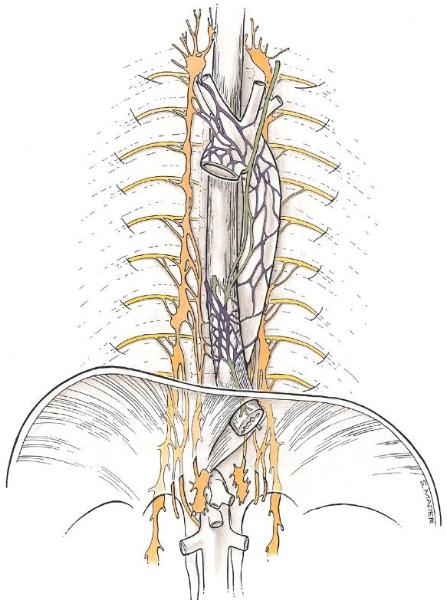Nerve Supply
Copyright 2008
Joshua Namias MD
The esophagus is innervated by both the parasympathetic and sympathetic nervous system. As described in previous sections, the esophageal motility pattern is quite complex with a voluntary and involuntary component. As such, there is a quite sophisticated efferent and afferent system that provides ongoing regulation and impulse control to the muscular component of the esophagus.
Within the cervical portion of the esophagus the recurrent laryngeal nerve and vagus nerve provide the innervating fibers. The course of the recurrent laryngeal that comes off the vagus is different on the right and left. The left wide has to wrap around the aortic arch while the right side wraps around the right subclavian artery.
Within the superior mediastinum the left recurrent laryngeal nerve, in addition to the right and left vagus nerve proper, provide the nerve fibers. Sympathetic trunks join with the small vagal fibers to form the anterior and posterior pulmonary plexi. As the vagus continues its course through the mediastinum, it continues to branch and provide more distal innervating fibers. These smaller plexi and branches reconstitute into 1 or 2 main vagal trunks.
Sympathetic fibers originate in the intermediolateral corneal cells in the spinal cord. They traverse out of the spinal column and can travel up, down, or in the region where they exit. These nerves provide the efferent innervation. The afferent signals travel back, much along the same route, but enter the spinal cord through the posterior spinal nerve roots. This afferent/efferent communication is the key to proper muscle contractions.
The upper esophageal portion is innervated by the pharyngeal plexus with the more distal portion from branches of the superior cervical ganglia.
The stellate ganglia provide smaller nerve fibers, known as the ansae subclavia, that supply the thoracic esophagus. While in the lower thoracic portion, the greater thoracic splanchnic nerves are important.
Within the abdomen, the celiac plexus is formed, while the greater splanchnic nerve fibers and the right inferior phrenic nerve innervate the abdominal portion of the esophagus.
 Nerve Supply Nerve Supply |
| Courtesy Lippincott Williams & Wilkins GTA07008 code chest aorta esophagus nerve supply normal anatomy drawing |
